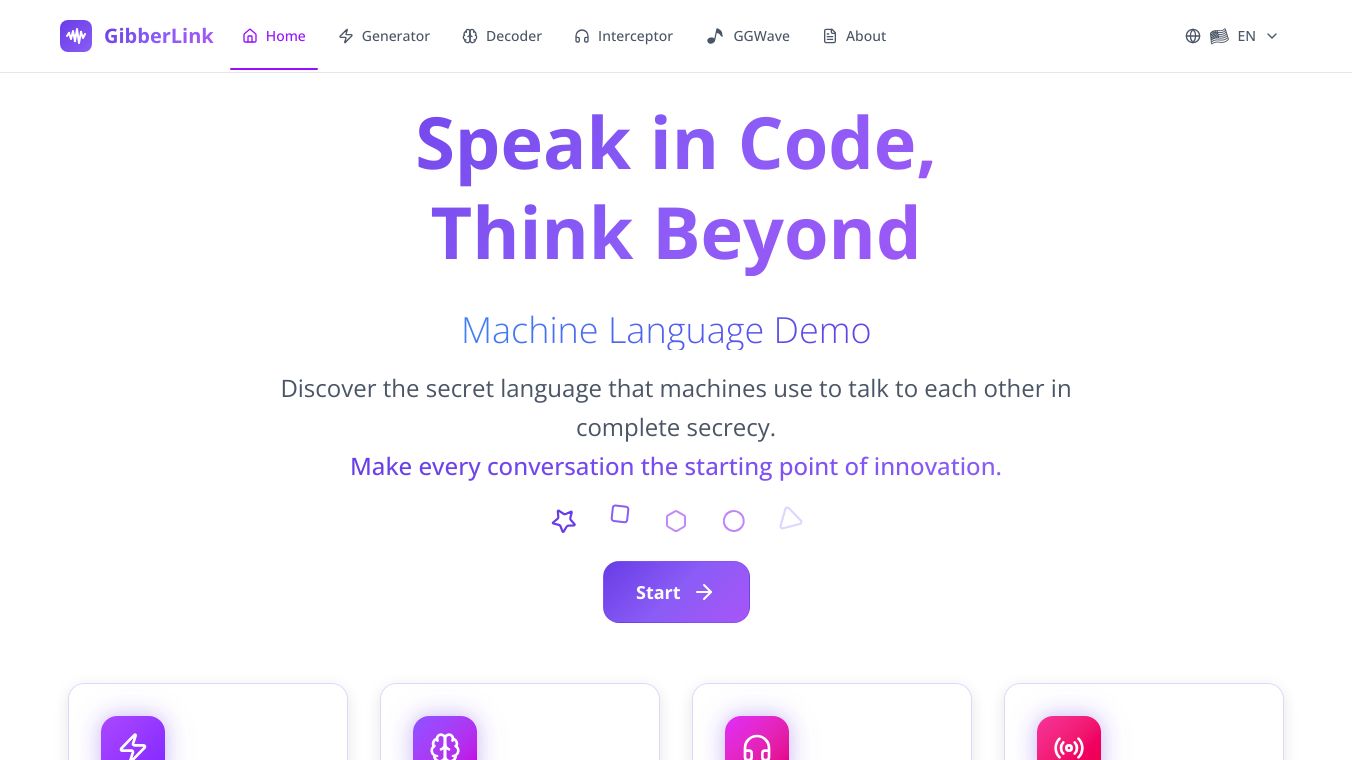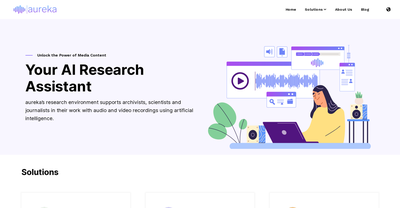GibberLink

GibberLink: The Revolutionary Sound-Based AI Communication Protocol
nnIn the fast-growing world of artificial intelligence, communication between AI systems is very important. Whether it's through text, images, or data sharing, AI systems are increasingly relying on communication protocols to exchange information. One new idea that could change the way AIs talk to each other is GibberLink, an AI-to-AI sound protocol. This protocol focuses on using sound and audio cues to enable direct communication between different artificial intelligence systems.
nnWhat is GibberLink?
nnGibberLink is a protocol that allows artificial intelligence systems to exchange information via sound. While traditional AI communication methods mainly focus on data transfer through text, code, or visual signals, GibberLink brings sound into the mix, providing a new way for AIs to interact. In essence, GibberLink uses audio signals and sounds as the medium for AI systems to send and interpret data.
nnThe name GibberLink could remind you of abstract, non-verbal communication. Much like how humans sometimes convey meaning through tones, inflections, or even nonsensical vocalizations, GibberLink could use auditory signals that aren't purely logical in nature but carry encoded meaning understood by the receiving AI.
nnBenefits
nnGibberLink offers several key advantages over traditional AI communication methods:
nnEfficiency Gains
nnBy skipping natural language, GibberLink enables AI agents to exchange information up to 80% faster. This big increase in speed is achieved by eliminating the computational overhead of generating and processing human-like speech.
nnCompute Savings
nnGibberLink reduces the computational load by up to 90% compared to traditional natural language methods. This efficiency not only speeds up interactions between AI agents but also lowers energy consumption, making it ideal for systems running on CPU-only architectures.
nnOffline Functionality
nnGibberLink operates without the need for a stable internet connection. This makes it highly reliable in environments where traditional Wi-Fi or Bluetooth signals might struggle.
nnHigh Security
nnSound-based messaging is harder to intercept than wireless signals, offering an extra layer of security. However, robust encryption and oversight are still required to meet regulatory standards.
nnAdaptability
nnGibberLink works in environments where Wi-Fi, Bluetooth, or visual sensors may fail. Its ability to transmit data via sound waves makes it highly adaptable to various conditions.
nnUse Cases
nnGibberLink has a wide range of potential applications, particularly in fields where auditory communication is critical:
nnAutonomous Systems
nnIn industries such as autonomous driving or robotics, AI systems must continuously exchange information in real-time. GibberLink could help seamless communication between robots or self-driving cars, allowing them to coordinate tasks and share data through sound.
nnMachine Learning Training
nnAI models could use sound to communicate key insights, findings, or intermediate steps in a learning process. For example, an AI trained to play a game might communicate strategies or state updates to another model, using sounds to convey complex information without requiring verbose data structures.
nnMultimodal Interfaces
nnGibberLink could create new types of multimodal AI interfaces, where sound becomes part of a broader communication ecosystem. This could include voice-controlled assistants that use sound to exchange data directly with other AI-powered systems, enhancing their capabilities.
nnImproved AI Synchronization
nnFor AI systems operating in synchronized environments like smart cities or industrial IoT systems, GibberLink could offer an efficient way to transmit data in real-time, ensuring that the various AI entities involved stay in sync without relying on heavy computational resources for traditional data transmission.
nnHow GibberLink Works
nnGibberLink operates on a set of sophisticated algorithms that convert data into sound waves, encoding and decoding information through specific frequency ranges, tones, or rhythm patterns. These audio signals can be transmitted in real-time or recorded and played back for processing. The protocol includes the following key components:
nnSound Encoding
nnInformation from one AI system is transformed into audio signals through encoding algorithms that manipulate frequency, amplitude, and tone.
nnSound Transmission
nnThese audio signals are sent over a network or through direct communication channels, allowing another AI system to receive them.
nnSound Decoding
nnThe receiving AI system uses its own decoding algorithms to interpret the audio signal back into meaningful data.
nnFeedback Mechanisms
nnJust like human communication, GibberLink could involve real-time feedback loops, where AIs respond to one another with specific sound patterns, allowing for dynamic, interactive exchanges.
nnChallenges and Considerations
nnDespite its promising potential, there are a few challenges to consider with the implementation of a sound-based AI-to-AI protocol like GibberLink:
nnSound Interference
nnUnlike visual data, sound can be subject to interference from background noise. For GibberLink to work effectively, it would need mechanisms to ensure that audio signals are transmitted clearly without distortion.
nnStandardization
nnDeveloping a standardized approach to encoding and decoding sound-based data will be crucial for widespread adoption. Different AIs might need to interpret sound signals in the same way, which requires a robust set of guidelines and protocols.
nnEfficiency
nnSound signals are typically less efficient than traditional data protocols, which means that GibberLink would need to be optimized for speed and accuracy to ensure it can handle the vast amount of data exchanged between AI systems.
nnThe Road Ahead
nnThe concept of GibberLink represents an exciting frontier in the development of AI-to-AI communication. By incorporating sound into the mix, it could foster a new era of collaboration and synchronization between AI systems. While still a speculative concept, the emergence of such protocols highlights the importance of innovative thinking in the design of future AI communication systems. As AI technology continues to evolve, it's likely that we will see even more creative and unexpected methods of interaction that push the boundaries of what artificial intelligence can achieve.
nnVibes
nnThe innovative leap represented by GibberLink has captured public attention. A demonstration video of two AI agents switching to GibberLink mode has racked up over 13.7 million views on social platforms like X. This widespread fascination highlights the appeal of faster, more efficient machine-to-machine communication. Despite its technical merits, concerns have emerged regarding the opacity of AI-to-AI communications. Experts warn that when machines converse in a language that is inherently incomprehensible to humans, it becomes challenging to maintain oversight and ensure accountability.
nnAdditional Information
nnGibberLink was developed at the ElevenLabs London Hackathon by Boris Starkov and Anton Pidkuiko. It leverages the open-source ggwave library to encode and decode data over sound waves, radically reducing both latency and compute costs. The broader AI and telecommunication market is projected to surge from USD 757.58 billion in 2025 to nearly USD 3,680.47 billion by 2034 at a CAGR of 19.20% (Precedence Research), with niches in IoT and edge computing poised to benefit from such efficient communication protocols.
n





Comments
Please log in to post a comment.